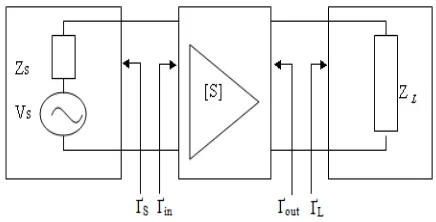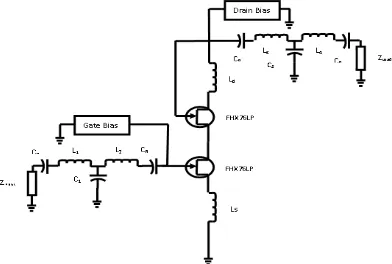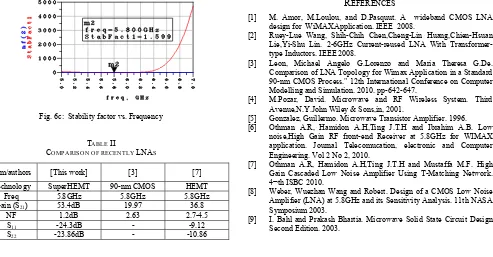Vol. 2 (2012) No. 1 ISSN: 2088-5334
Design of LNA at 5.8GHz with Cascode and Cascaded Techniques
Using T-Matching Network for Wireless Applications
Abu Bakar Ibrahim
1, Mohd Nor Husain
2, Abdul Rani Othman
3, Mohammad Syahrir Johal
4Faculty of Electronic and Computer Engineering Universiti Teknikal Malaysia Melaka, Hang Tuah Jaya,
76100 Durian Tunggal Melaka, Malaysia
E-mail: [email protected] ,[email protected], [email protected] ,[email protected]
Abstract—This paper presents the design of low noise amplifier with cascode and cascaded techniques using T-matching network applicable for IEEE 802.16 standards. The amplifier use FHX76LP Low Noise SuperHEMT FET. The design simulation process is using Advance Design System (ADS) software. The cascode and cascaded low noise amplifier (LNA) produced gain of 53.4dB and noise figure (NF) of 1.2dB. The input reflection (S11) and output return loss (S22) are -24.3dB and -23.9dB respectively .The input sensitivity is compliant with the IEEE 802.16 standards.
Keywords— Cascode and Cascade LNA; Radio Frequency; T -Matching Network.
I. INTRODUCTION
The numbers of systems that use radio frequencies links are increasing quickly. At the same time, the number of standards for such systems is increasing very quickly as well. To make this possible the number of frequency band dedicated for wireless communication has also increased [1].WiMAX, which is short for Worldwide Interoperability for Microwave Access, is a novel wireless communication technology. It is an attractive technology due to the high transmitting speed (up to 70Mbps) and long transmitting distance (up to 30 mile). The system based on IEEE 802.16 standards and uses several bands (2.3-2.7 GHz, 3.4-3.6 Hz and 5.1-5.8GHz) to transmit data. The design of the front-end low noise amplifier is one of the challenges in Radio Frequency (RF) receivers, which needs to provide good input impedance match, enough power gain and low Noise Figure (NF) within the required band [2]. Many high gain amplifier topologies have been proposed as a way to satisfy the requirement for low power dissipation as well as good performances. The cascode with cascaded techniques for produces results in a higher bandwidth and gain, due to the increase in the output impedance, as well as better isolation between the input and output ports [3-8]. The overall low noise amplifier should introduce a higher gain of 50 dB compared to report [6-7]. By taking consideration the extension of communication distance up to 50 km [6].In this
work, low noise amplifier with cascode and cascaded techniques (3-stage) is proposed a shown in figure 1.
Fig. 1: Proposed for Cascode and Cascaded LNA diagram block
II. THEORETICAL SECTIONS
Basically, designing an amplifier, the input and output matching network are considered to achieve the required stability, small signal gain, and a bandwidth. Super high frequency amplifier is a typical active circuit used to amplify the amplitude of radio frequency signal. Basic concept and consideration in design of super high frequency amplifier is presented in this paper. The LNA design formula and equation were referred to [4]. Figure 2, shows a typical single-stage amplifier including input/output matching networks. The basic concept of high frequency amplifier design is to match input/output of a transistor at high frequencies using S-parameters frequency characteristics at a specific DC-bias point with source impedance and load
impedance. Input/output matching circuit is essential to reduce the unwanted reflection of signal and to improve efficiency of the transmission from source to load [4, 5].
Fig. 2: Typical amplifier design
A. Power Gain
Several power gains were defined in order to understand operation of super high frequency amplifier, as shown in Figure 3, power gains of 2-port circuit network with power impedance or load impedance at power amplifier represented with scattering coefficient are classified into Operating Power Gain, Transducer Power Gain and Available Power Gain [4, 5].
Fig. 3: I/O circuit of 2-port network
B. Operating Power Gain
Operating power gain is the ratio of power (PL) delivered to the load (ZL) to power (Pin) supplied to 2-port network. Power delivered to the load is the difference between the power reflected at the output port and the input power, and power supplied to 2-port network is the difference between the input power at the input port and the reflected power. Therefore, Operating Power Gain is represented by
2
Where, in indicates reflection coefficient of load at the
input port of 2-port network and s is reflection coefficient of power supplied to the input port.
C. Transducer Power Gain
Transducer Power Gain is the ratio ofPavs, maximum power available from source toPL, power delivered to the load. As maximum power is obtained when input impedance of circuit network is equal to conjugate complex number of
power impedance, if in =s , transducer power gain is represented by
2 where, L indicates load reflection coefficient.
D. Available Power Gain
Available Power Gain GA is the ratio of Pavs , power available from the source, toPavn, power available from
2-port network, respect
avs
That is, the above formula indicates power gain when input and output are matched [5].
E. Noise Figure
Signals and noises applied to the input port of amplifier were amplified by the gain of the amplifier and noise of amplifier itself is added to the output. Therefore, SNR (Signal to Noise Ratio) of the output port is smaller than that of the input port. The ratio of SNR of input port to that of output port is referred to as noise figure and is larger than 1 dB. Typically, noise figure of 2-port transistor has a minimum value at the specified admittance given by formula:
2
For low noise transistors, manufactures usually provide
opt N Y R
Fmin, , by frequencies. N defined by formula for
desired noise figure:
F. Condition for Matching
The scattering coefficients of transistor were determined. The only flexibility permitted to the designer is the input/output matching circuit. The input circuit should match to the source and the output circuit should match to the load in order to deliver maximum power to the load. After stability of active device is determined, input/output matching circuits should be designed so that reflection coefficient of each port can be correlated with conjugate complex number as given below [7].
TABLE I COMPONENTS OF MATCHING
LNA Components Matching
L1 L2 L3 L4 C1 C2
Cascode 6.1 nH 2.4 nH 1.5 nH 1.6 nH 0.3 pF 0.4pF
Single 3.7nH 0.8nH 3.6 nH 0.8 nH 0.5 pF
L L S
IN
S S S S
22 21 12 11 *
1 (6)
S S L
OUT
S S S S
11 21 12 22 *
1 (7)
The noise figure of the first stage of the receiver overrules noise figure of the whole system. To get minimum noise figure using transistor, power reflection coefficient should match with optand load reflection coefficient should match
with out*
s
=opt (8)
s s out
L
S S S S
11 21 12 22 *
1 (9)
III.DESIGN OF LNA
The overall performance of the low noise amplifier is determined by calculating the transducer gain GT, noise
figure NF and the input and output standing wave ratios, VSWRIN and VSWROUT. The optimum, Γopt and ΓL were
obtained as Γopt = 17.354 + j50.13 and ΓL = 79.913-j7.304
for single LNA. While, Γopt = 21 + j48.881 and ΓL = 79.913-
j7.304 for cascode LNA. Figure 4 shows, the complete schematic circuit of cascode LNA and Figure 5 shows the completed schematic circuit of a single LNA. A T-matching network is used to match the input impedance. The elements of T-network can be realized in the form of lump reactive elements. The resultant matching component values are given in Table I.
Fig. 4: The Schematic Circuit for Cascode LNA
Fig. 5: The Schematic Circuit for Single LNA
IV.SIMULATION RESULTS
Table II shows the s-parameters output for comparison of LNA. It is simulated using Advanced Design System (ADS). The simulation recorded that the amplifier gain S21 is
53.4dB.The input insertion loss S11 is -24.3dB, overall noise
figure (NF) is 1.2dB and the output insertion loss S22 is
-23.9dB.The reflection loss S12 is -62.6dB. These values were
within the design specification and were accepted. The output S-parameter is shows in consistence figure 6a, 6b and 6c. Table III shown the comparison of recently LNA reported.
TABLE II
COMPARISON OF OUTPUT LNAS
S-Parameters
(dB) S11 S12 S21 S22 NF (k)
Single LNA -12.8 -20.2 17.0 -27.9 0.76 1.02
Cascode LNA -18.9 -22.1 19.5 -20.0 1.2 1.02 Cascaded LNA -22.5 -40.4 34 -37.6 0.76 1.29 cascode and
cascaded -24.3 -62.6 53.4 -23.86 1.20 1.59
Fig. 6a: S-parameters Output for LNA
Fig. 6b: Noise Figure vs. frequency
Fig. 6c: Stability factor vs. Frequency
TABLE II
COMPARISON OF RECENTLY LNAS
Item/authors [This work] [3] [7]
Technology SuperHEMT 90-nm CMOS HEMT Freq 5.8GHz 5.8GHz 5.8GHz
Gain (S21) 53.4dB 19.97 36.8
NF 1.2dB 2.63 2.7-4.5
S11 -24.3dB - -9.12
S22 -23.86dB - -10.86
V. CONCLUSION
A 5.8GHz cascode and cascaded low noise amplifier is successful design and simulated. The amplifier uses the T-matching network in input of LNA. At 5.8GHz, gain (S21) of LNA is recorded that the amplifier gain S21 is 53.4dB. The input insertion loss S11 is -24.3dB and the output insertion loss S22 is 23.9dB. The reflected loss S12 is -62.6dB. The better performance in gain of the amplifier, it can be achieved by increasing the number of stages to improve the gain and noise figure of the design. For this reason the cascoded and cascaded is proposed.
REFERENCES
[1] M. Amor, M.Loulou, and D.Pasquut. A wideband CMOS LNA design for WiMAXApplication. IEEE 2008.
[2] Ruey-Lue Wang, Shih-Chih Chen,Cheng-Lin Huang,Chien-Hsuan Lie,Yi-Shu Lin. 2-6GHz Current-reused LNA With Transformer-type Inductors. IEEE 2008.
[3] Leon, Michael Angelo G.Lorenzo and Maria Theresa G.De. Comparison of LNA Topology for Wimax Application in a Standard 90-nm CMOS Process." 12th International Conference on Computer Modelling and Simulation. 2010. pp-642-647.
[4] M.Pozar, David. Microwave and RF Wireless System. Third Avenue,N.Y.John Wiley & Sons,in, 2001.
[5] Gonzalez, Guillermo. Microwave Transistor Amplifier. 1996. [6] Othman A.R, Hamidon A.H,Ting J.T.H and Ibrahim A.B. Low
noise,High Gain RF front-end Receiver at 5.8GHz for WIMAX application. Journal Telecomucation, electronic and Computer Engineering. Vol 2 No 2, 2010.
[7] Othman A.R, Hamidon A.H,Ting J.T.H and Mustaffa M.F. High Gain Cascaded Low Noise Amplifier Using T-Matching Network. 4¬th ISBC 2010.
[8] Weber, Wuezhan Wang and Robert. Design of a CMOS Low Noise Amplifier (LNA) at 5.8GHz and its Sensitivity Analysis. 11th NASA Symposium 2003.
[9] I. Bahl and Prakash Bhartia. Microwave Solid State Circuit Design Second Edition. 2003.
![Figure (NF) within the required band [2]. Many high gain](https://thumb-ap.123doks.com/thumbv2/123dok/554525.65309/1.595.343.531.473.555/figure-nf-required-band-high-gain.webp)


